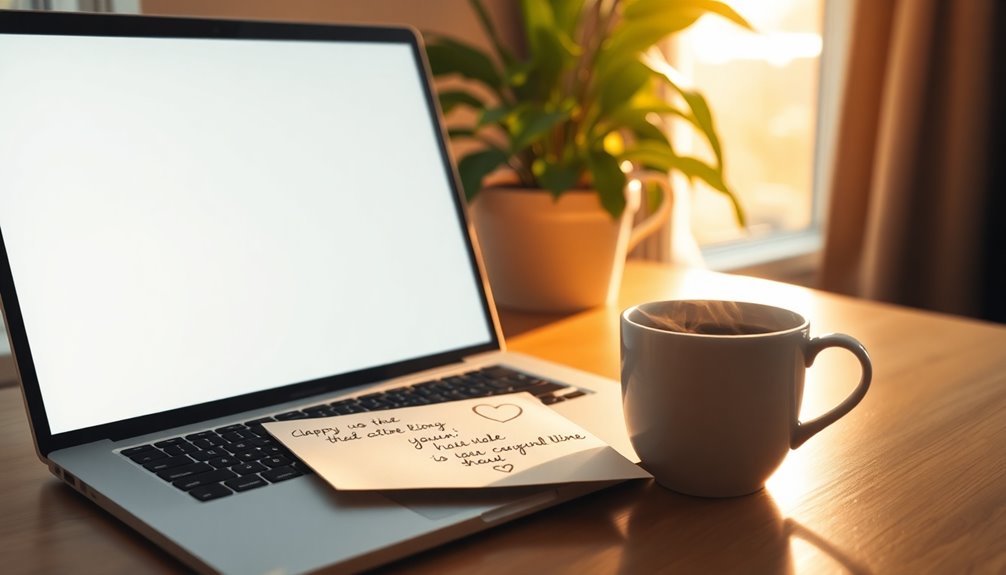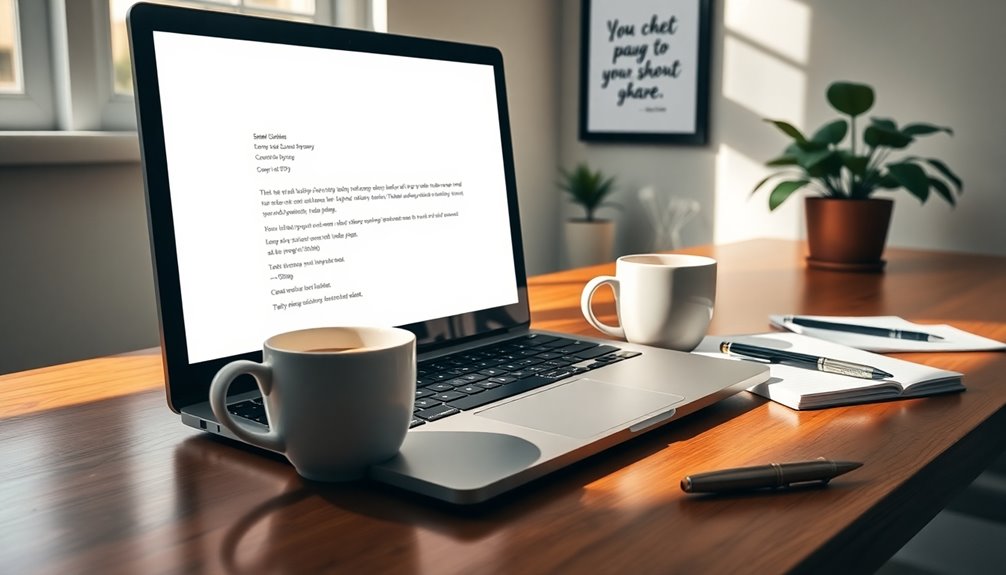To write a warm and memorable farewell email, start by expressing sincere gratitude for your colleagues and shared experiences. Reflect on specific memories or achievements that highlight your relationships. Personalize your message to resonate emotionally, and keep it positive and concise—one or two paragraphs is ideal. Send your email 1-2 days before your departure to maximize engagement. Lastly, provide your personal contact information to encourage future connections. End with a heartfelt closing that leaves a lasting impression, inspiring your colleagues to remember you fondly. There's more to consider for crafting the perfect farewell message ahead!
Key Takeaways
- Express genuine gratitude for shared experiences and achievements to create a warm tone in your farewell email.
- Personalize your message by including specific memories or anecdotes that highlight your relationships with colleagues.
- Keep your farewell email concise, limiting it to one or two paragraphs to maintain clarity and focus.
- Provide your personal contact information to encourage ongoing connections and networking opportunities after your departure.
- End on a positive note, inspiring colleagues to remember the good times and maintain professional relationships.
Introduction

Writing a farewell email is an important step that many people overlook when leaving a job. This email serves as a chance to express gratitude for the time spent with colleagues and clients, reinforcing professional etiquette.
It's your opportunity to reflect on shared achievements and foster emotional connections that can last beyond your departure.
Make sure to personalize your farewell email with specific memories that highlight your journey together. This personal touch not only makes the email memorable but also creates a warm atmosphere that encourages a positive tone.
Aim to send your farewell email a day or two before your last working day. This timing ensures everyone's aware of your departure without overwhelming them with distractions.
Don't forget to include clear contact information in your email. This gesture helps maintain professional relationships and opens the door for future communication.
A concise and focused message will enhance the overall impact of your farewell email, leaving a lasting impression on your colleagues.
Build Lasting Professional Relationships
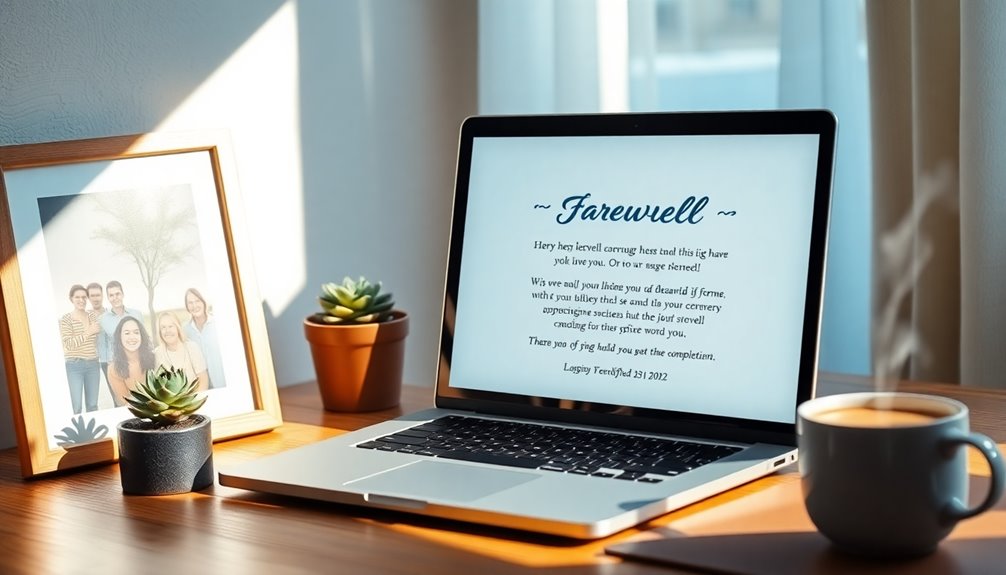
Crafting a farewell email not only serves as a goodbye but also opens the door to building lasting professional relationships. By expressing gratitude in your farewell message, you foster goodwill and encourage future networking opportunities.
Use goodbye email templates to help structure your thoughts, but make sure to personalize them for different recipients, like peers, managers, and clients. This shows you appreciate their unique contributions to your journey.
Including your personal contact information is crucial; it promotes ongoing communication and connection. Remind your colleagues of shared experiences and achievements, as this reinforces emotional ties and creates lasting memories. Highlighting these moments not only strengthens your relationships but also leaves a positive impression as you transition to new opportunities.
Maintaining a positive tone throughout your farewell email can make all the difference. Focus on happy memories and the lessons learned, which can enhance your professional reputation.
As you wrap up, encourage everyone to keep in touch, ensuring that the bonds you've built endure beyond your time at the organization. By taking these steps, you'll pave the way for continued professional relationships that can benefit you in the future.
Personalized Closing Statement
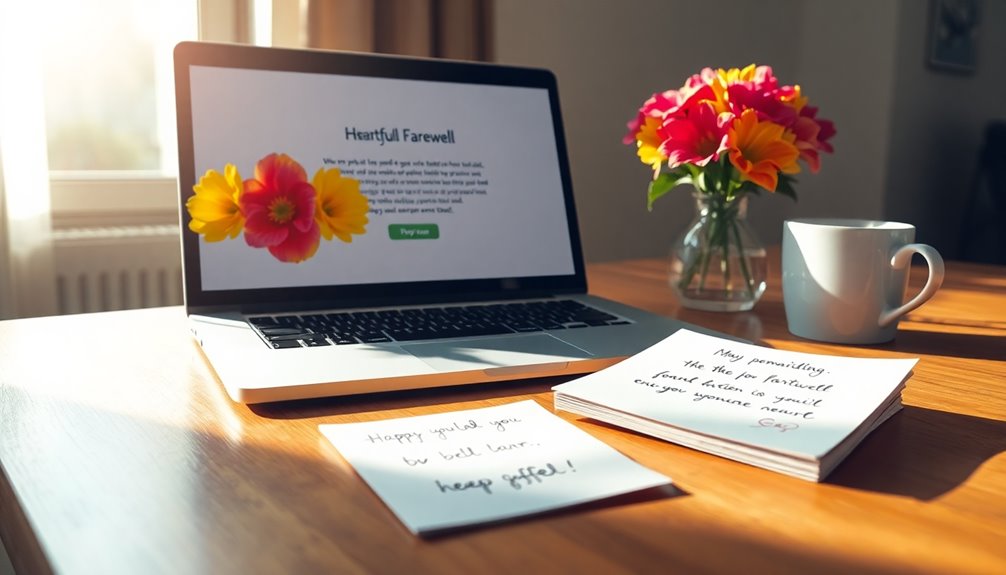
As you approach the end of your farewell email, a personalized closing statement can truly enhance the emotional connection with your colleagues. By expressing genuine gratitude and well-wishes tailored to individual relationships, you create a warm tone that resonates.
Consider including a specific memory or shared experience; it evokes nostalgia and makes your farewell feel heartfelt and sincere. You might say something like, "I'll always treasure our late-night brainstorming sessions," to remind them of the collaborative spirit you shared. This acknowledgment of collective achievements reinforces the bond you've built over time.
Moreover, inviting your colleagues to keep in touch fosters ongoing professional relationships. Offering your personal contact information not only encourages networking opportunities but also shows your commitment to maintaining those connections.
Ending with a positive note, like "Wishing you all the best in your future endeavors," leaves a lasting impression.
Crafting Your Farewell Message

When creating your farewell message, start with a warm and engaging subject line to set a positive tone. Something like "Thank You and Farewell" can instantly resonate with your colleagues.
In your farewell email, express genuine gratitude for the support and experiences you've gained during your time together. Highlight the positive relationships you've built and the impact your colleagues have had on your journey.
Incorporate personal anecdotes or specific memories shared with your team. This adds a heartfelt touch and helps create a lasting connection. For example, reminisce about a successful project you collaborated on or a fun team outing. These memories shared will remind everyone of the good times.
Remember to keep your message concise, ideally within one or two paragraphs. This ensures clarity and maintains your readers' attention.
At the end of your email, include your contact information, like your personal email or LinkedIn profile, encouraging your colleagues to keep in touch. A warm tone throughout your farewell email will leave a memorable impression, ensuring that your professional network remains strong even after you've moved on.
Dos and Don'ts for Farewell Emails

After you've set the tone with your farewell message, it's important to follow some key dos and don'ts to ensure your email resonates positively.
First, do keep it positive. Focus on expressing gratitude and appreciation for the relationships and experiences you've built during your time at the company. Avoid negative comments, as they can overshadow your message.
Next, do personalize your message. Include specific memories or anecdotes that highlight your connections with colleagues. This adds a heartfelt touch and makes your farewell more memorable. Remember to be concise and focused; limit your email to one or two paragraphs to maintain clarity.
Don't forget to include your contact information. Always provide your personal email or phone number so colleagues can easily reach out after your departure.
Lastly, consider your timing carefully. Send your farewell email a day or two before your last day to give colleagues a chance to respond and engage without distractions.
Examples of Farewell Emails
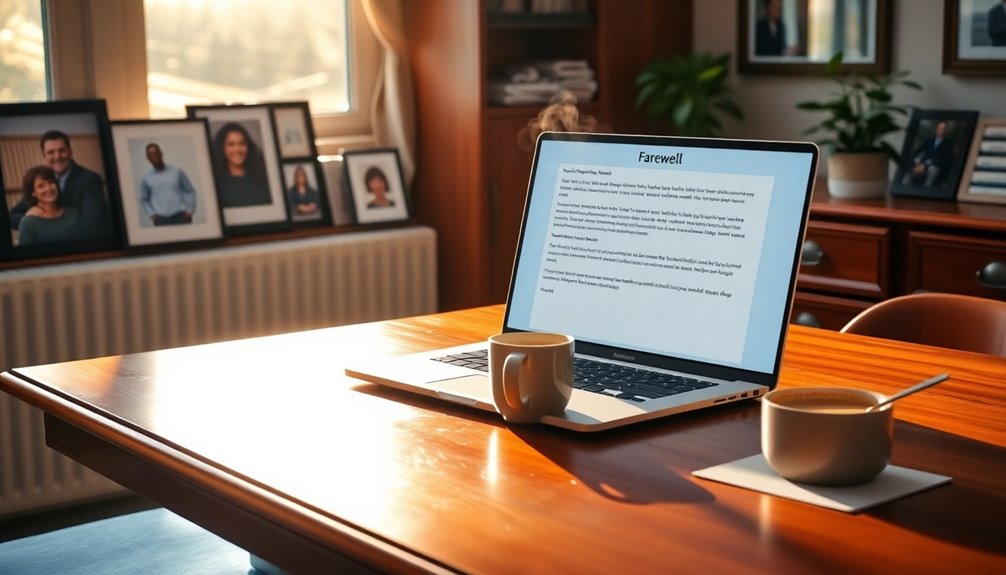
Crafting a farewell email can feel daunting, but it doesn't have to be. Start with a clear subject line like "Saying Goodbye" or "Thank You" to grab attention.
Personalize your message by recalling specific memories or achievements with your team members. For instance, you might say, "I'll always cherish our late-night brainstorming sessions that led to our successful project launch." This helps create a warm and memorable tone.
Next, express genuine gratitude towards your colleagues, supervisors, and mentors. A simple acknowledgment like, "Thank you all for your support and encouragement throughout my journey here," reinforces positive relationships.
You want to leave on a positive note, ensuring your team knows how much they've meant to you.
Pro Tips for Writing Effective Emails

To ensure your farewell email resonates with your colleagues, focus on clarity and purpose from the start. Use a clear and concise subject line that reflects your sentiment, like "Thank You and Farewell." This sets the tone and captures attention immediately.
Keep your email brief—ideally one to two paragraphs. Express gratitude for the experiences you've shared and the relationships you've built during your time together.
Personalize your message by including specific memories or achievements that highlight your connections with your colleagues. This adds warmth and fosters nostalgia, making your farewell more memorable.
Maintain a positive and professional tone throughout your email; avoid negative comments about the workplace or individuals, as you want to leave a lasting positive impression.
Don't forget to provide your personal contact information at the end of the email. This encourages future communication and networking opportunities, helping you maintain those valuable relationships.
Final Thoughts

Leaving your workplace is a significant moment, and your farewell email can truly make it memorable. When crafting this message, focus on expressing gratitude for the positive experiences you've shared with your colleagues. Highlight specific memories or achievements to enhance emotional connections, making your email stand out.
Timing is crucial; aim to send your farewell email a day or two before your final departure. This gives everyone a chance to respond and connect, reinforcing those professional relationships you've built. Maintain a positive tone throughout your email, steering clear of any negative comments. This not only leaves a lasting impression but also contributes to a supportive workplace culture.
Don't forget to include your contact information. This encourages ongoing networking opportunities and ensures that valuable connections remain intact, even after you leave.
A well-crafted farewell email reflects your appreciation for the time spent together and can foster goodwill among your colleagues. As you move on to new adventures, remember that the relationships you've formed here might lead to exciting opportunities in the future.
Embrace this moment, and let your farewell email resonate with warmth and positivity.
Frequently Asked Questions
How to Write a Professional Goodbye Email?
When you're writing a professional goodbye email, start with a clear subject line like "Thank You."
Express genuine gratitude to your colleagues and supervisors for their support during your time there.
Keep it concise—one to two paragraphs should do.
Include your personal contact information to stay connected.
Aim to send it a day or two before your last day, so everyone has time to read it and respond.
How Do You Write a Heartfelt Farewell Message?
To write a heartfelt farewell message, start by expressing genuine gratitude for the relationships you've built.
Reflect on specific moments that made your time special, and don't hesitate to share inside jokes or anecdotes that evoke fond memories.
Maintain a positive tone, focusing on the future and opportunities ahead.
Include your personal contact information to stay connected, and conclude with well-wishes for your colleagues' future endeavors, leaving them with a lasting, positive impression.
How Do You Say Goodbye Professionally?
When you're saying goodbye professionally, keep it sincere and positive. Thank your colleagues and supervisors for their support and the experiences you shared.
Be sure to mention who'll take over your responsibilities to ensure a smooth transition. Include your personal contact information so you can stay connected.
Sending your message a day or two before you leave gives everyone time to respond and allows for meaningful farewells.
How to Write a Goodbye Message When Leaving a Job?
When you're crafting a goodbye message for your job, focus on expressing gratitude for the experiences you've shared.
Mention specific moments that made your time memorable and appreciate the support from your colleagues.
Keep it concise, ideally one or two paragraphs, and don't forget to include your contact information so others can stay in touch.
Sending it a day or two before your last day gives everyone a chance for final goodbyes.
